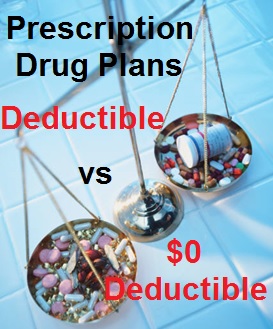One of the first options a Medicare beneficiary faces when they are reviewing Part D Prescription Drug plans (PDP) is whether they want a plan with a deductible. The deductible amount, set by Medicare, is the dollar amount a plan member must pay before he or she is eligible for the reduced copayment for the drugs. The big decision for the Medicare beneficiary is if they should select a PDP with a lower premium and $310 deductible or pay a higher monthly premium for a no deductible plan.
Extra cost, no benefit for $0 deductible PDPs
Part D plans with a deductible usually have a lower monthly premium than plans that have no deductible. The $0 deductible plans allow members to start paying copayments for prescriptions right when the plan starts. While the extra cost of the monthly premium for a plan with a $0 deductible might be negligible for someone with expensive brand name medications, there may be no monetary savings for someone who uses primarily generic drugs.
Deductible prescription plans have lower premiums
For a Medicare beneficiary that uses only a few generic medications, selecting a plan with a deductible might be the best option. Generic prescription medications have become very competitively priced between the different large pharmacies. The prices paid for a 30 day supply of a generic medication can sometimes be lower than the generic copayment price of a PDP. Consequently, perspective and current PDP members should analyze their annual drug costs to determine if purchasing a PDP with a deductible makes more sense than higher priced PDP with $0 deductible.
$0 Deductible verses Deductible PDP
In this example we have a person that is taking five different generic medications. The retail cost of the prescriptions, based on the latest Walmart prescription drug prices, shows that their annual pharmacy cost would never exceed the $310 deductible offered by many plans. When we compare the total costs (premium + drugs) between a plan with deductible and a plan with $0 deductible, selecting a plan with no annual drug deductible is actually more expensive because of the higher monthly premium.
| 30 Day* | Annual | ||
| Prescription | Retail $ | Cost | |
| Naproxen | Arthritis pain | $4 | $48 |
| Lovastatin | Cholesterol | $4 | $48 |
| Lisinopril | Blood Pressure | $4 | $48 |
| Fluoxetine | Mental health | $4 | $48 |
| Levothyroxine | Thyroid | $4 | $48 |
| $240 |
*Based on Walmart pricing included at end of post.
$0 Deductible tier prices
When we look at a typical PDP $0 deductible copayment pricing structure for the same drugs, they are actually more expensive than the retail cost.
| Annual | |||
| Prescription | Tier | Copay | Cost |
| Naproxen | 2 | $5 | $60 |
| Lovastatin | 2 | $5 | $60 |
| Lisinopril | 1 | $2 | $24 |
| Fluoxetine | 2 | $5 | $60 |
| Levothyroxine | 2 | $5 | $60 |
| $264 |
Adding up all the costs
| Hypothetical Monthly PDP Plans | ||
| $310 deductible | $0 deductible | |
| Monthly Premium | $25 | $50 |
| Annual Premium | $300 | $600 |
| Annual Rx Costs | $240 | $264 |
| Premium + Rx | $540 | $864 |
The disparity in annual total cost is even greater if the $310 deductible PDP has even lower copayments than the retail pricing shown in the example. Because the pricing for every pharmacy and PDP plan is different, along with the drug formulary, it’s necessary to compare all the plans side by side. Medicare prescription drug plans can yield tremendous savings for folks taking expensive brand name medications. But some plans with a zero deductible amount can actually end up costing the member more at the end of the year.
[gview file=”https://insuremekevin.com/wp-content/uploads/2014/02/Walmart_generic_Rx_2_7_14.pdf” save=”1″]
Another source of retail generic prescription drug pricing can be found at the Costco Pharmacy website.
